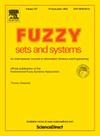Ordinal sum combinations of continuous t-norms and their related ordered algebraic structures
IF 2.7
1区 数学
Q2 COMPUTER SCIENCE, THEORY & METHODS
引用次数: 0
Abstract
Recently, Vemuri et al. (2023) [15] proposed two operators for constructing new continuous t-norms with the intent of integrating the ordinal sum structures of given ones. Unfortunately, these two operators on non-trivial ordinal sum t-norms are not well-defined so that almost all the results in that part as well as some ones of the following papers are incorrect. The purpose of this paper is to revisit such topic, to redefine a pair of combination operations and to study their related ordered algebraic structures. It is proved that our redefined operations both satisfy the laws of commutativity, associativity, idempotency, and finer absorption, and take the minimum t-norm as the absorption and neutral elements, respectively. Since these operations will finerize in general the subintervals of the underlying t-norms, it is impossible to make the set of all continuous t-norms a lattice under these two operations, and then we turn to find the sufficient and necessary conditions for these operations to be lattice operations and get finally many distributive sublattices of continuous t-norms. Among four possible pairs of ordinal sum combination operations on continuous t-norms, the pair defined in the text matches every well and induces the richest distributive sublattice structures. Lastly, our redefined operations are applied to the contexts of -implications and residual implications with continuous t-conorms and t-norms, respectively.
连续t模的有序和组合及其相关的有序代数结构
最近,Vemuri等人(2023)[15]提出了两个算子用于构造新的连续t-norm,目的是对给定t-norm的有序和结构进行积分。不幸的是,这两个算子在非平凡有序和t-范数上并没有很好的定义,所以这部分的结果几乎都是不正确的,下面的一些论文的结果也不正确。本文的目的是重新审视这一问题,重新定义一对组合运算,并研究它们相关的有序代数结构。证明了我们重新定义的运算既满足交换律、结合律、幂等律和细吸收律,又分别以最小t范数作为吸收元和中性元。由于这些操作一般都是对底层t模的子区间进行精化处理,因此在这两种操作下,所有连续t模的集合都不可能是格,然后我们开始寻找这些操作是格操作的充要条件,最后得到连续t模的分布子格。在连续t-范数上的四种可能的有序和组合操作对中,本文定义的对与每一对都匹配良好,并推导出最丰富的分布子格结构。最后,我们重新定义的运算分别应用于具有连续t形和t模的(S,N)蕴涵和残差蕴涵的上下文。
本文章由计算机程序翻译,如有差异,请以英文原文为准。
求助全文
约1分钟内获得全文
求助全文
来源期刊

Fuzzy Sets and Systems
数学-计算机:理论方法
CiteScore
6.50
自引率
17.90%
发文量
321
审稿时长
6.1 months
期刊介绍:
Since its launching in 1978, the journal Fuzzy Sets and Systems has been devoted to the international advancement of the theory and application of fuzzy sets and systems. The theory of fuzzy sets now encompasses a well organized corpus of basic notions including (and not restricted to) aggregation operations, a generalized theory of relations, specific measures of information content, a calculus of fuzzy numbers. Fuzzy sets are also the cornerstone of a non-additive uncertainty theory, namely possibility theory, and of a versatile tool for both linguistic and numerical modeling: fuzzy rule-based systems. Numerous works now combine fuzzy concepts with other scientific disciplines as well as modern technologies.
In mathematics fuzzy sets have triggered new research topics in connection with category theory, topology, algebra, analysis. Fuzzy sets are also part of a recent trend in the study of generalized measures and integrals, and are combined with statistical methods. Furthermore, fuzzy sets have strong logical underpinnings in the tradition of many-valued logics.
 求助内容:
求助内容: 应助结果提醒方式:
应助结果提醒方式:


